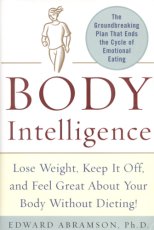 Excerpt
from Body Intelligence: Lose Weight, Keep It Off, and Feel Great About Your Body Without Dieting
Excerpt
from Body Intelligence: Lose Weight, Keep It Off, and Feel Great About Your Body Without Dieting
by Edward Abramson, Ph.D.
Eating Rituals
Eating because it is mealtime is not the only example of habits determining food consumption. Eating rituals may develop in certain situations regardless of the time of day. When you go to the movies, do you buy popcorn before taking your seat? Would it feel a little strange to watch the movie without nibbling on something? If this is one of your eating rituals, it doesn’t make any difference if you’re going to a matinee or an evening show, or if you had a meal right before the movie started. Whatever the circumstances, you will have the popcorn. Popcorn at movies, hot dogs and beer at baseball games, coffee and doughnuts at the morning work break, and milk and cookies after school are a few of the common eating rituals. In addition, most people develop their own, unique eating rituals.
Charles, a forty-five-year-old pharmaceutical salesman, was required to make a 200-mile trip every other week to call on doctors in a town at the far edge of his territory. He dreaded the long drive, especially the hour and a half he had to spend on a lengthy stretch of desolate interstate. After several months, a new Wendy’s opened at about the halfway point in the journey. Charles stopped for a chocolate Frosty one day, and he was hooked. It didn’t make any difference if he was traveling at 10:00 a.m., 4:30 p.m., or 8:00 p.m. If he had a meal before leaving, the Frosty was his dessert. If he was going to eat when he arrived, it was an appetizer. Regardless of the time of day, or the amount of time that had elapsed since his last meal, every trip included a stop for the Frosty.
Katherine, a thirty-seven-year-old social worker, would come home from work and have dinner with her family. As soon as the dishes were done, she would make herself a huge bowl of popcorn, grab a bunch of grapes (when in season), and get into bed and watch the soap operas she had prerecorded. If popcorn and grapes weren’t available, she would search the pantry to find another food she could eat while watching her soaps. The taste of the food wasn’t as important as the eating-while-watching ritual.
Think about your own routines:
• Can you find examples of eating that occur in a specific situation regardless of your physical hunger or the time of day?
• Do you need a snack when watching television?
• Is there a task that you routinely perform that is followed by a treat?
• Do you reward yourself with a treat when you get home from work?
The sidebar, “Changing the Ritual,” offers some suggestions.
Katherine, the popcorn-eating, soap-opera watcher, rarely paid attention to the sensations of eating popcorn since she was usually involved in her soap opera. It was just a mindless activity that kept her hands busy. To give up this eating ritual, Katherine took up crocheting while watching her soaps. She left the yarn and needles on top of the television so she could grab them before getting into bed. Charles, the Frosty-loving pharmaceutical salesman, prepared a snack before his trip and then stopped at a rest area two exits before the Wendy’s. When the weather cooperated, he broke up his drive by taking a little walk and having his snack.
CHANGING THE RITUAL
Identify one of your frequent eating rituals. This is a type of eating that is not motivated by hunger or mealtimes, but by a specific set of circumstances such as going to the movies or coming home from work. Visual cues may be present, but they are not necessary for some rituals. In your notebook, briefly describe your ritual.
Where does this ritual usually take place? For example, you snack while watching television in the living room, or wherever you usually watch. Write these locations in your notebook.
Plan an alternative to eating when you are in the ritual situation. In your notebook, write down some specific activities you could do instead of eating, such as knitting while watching TV, holding hands in the movies, or drinking a glass of sparkling water when you get home from work.
Copyright © 2005 Edward Abramson, Ph.D.
